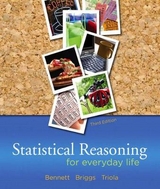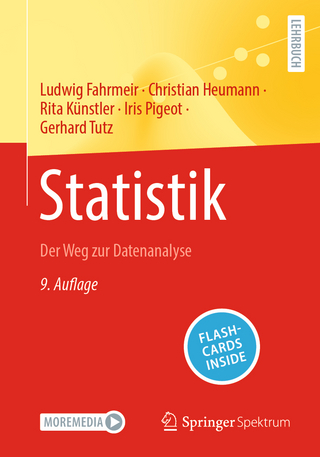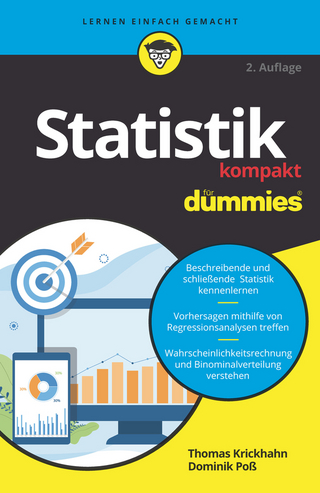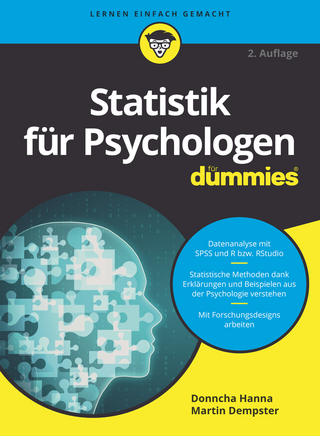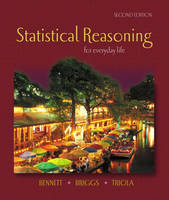
Statistical Reasoning for Everyday Life
Pearson (Verlag)
978-0-201-77128-2 (ISBN)
- Titel erscheint in neuer Auflage
- Artikel merken
The goals of the book are to help students develop an understanding of statistics and develop their statistical reasoning skills. This text approaches statistics by presenting an overall picture, then providing an explanation of the topics in context. Students develop an understanding of statistics that is reinforced in the exercises, Web projects, and Focus On features.
Jeff Bennett¿s academic home is the University of Colorado at Boulder, where he has been teaching on and off since 1983 and from which he received his Ph.D. in Astrophysics in 1987. During this time, he¿s taught more than 50 college courses in subjects including mathematics, astronomy, physics, environmental science, and science education. He began work on Using and Understanding Mathematics because he is particularly interested in helping students overcome difficulties with mathematics. For similar reasons, he has recently completed a textbook for introductory astronomy (The Cosmic Perspective, with M. Donahue, N. Schneider, and G.M. Voit, Addison Wesley Longman, 1999). He is also working on several books about mathematics and science for the general public. In addition, he is now working on science books for children. Jeff is perhaps best known for his role in creating the Voyage Scale Model Solar System on the National Mall in Washington, DC (opening October 2001); he proposed the project and worked on the team that developed it as a collaborative effort between the Challenger Center for Space Science Education, the Smithsonian Institution, and NASA. When not working, he enjoys participating in masters swimming and hiking the trails of Boulder, Colorado, with his family. William L. Briggs has been on the mathematics faculty at the University of Colorado at Denver for 17 years. He teaches throughout the undergraduate and graduate curriculum with a special interest in teaching mathematical modeling as it applies to problems in biology and medicine. He developed the quantitative reasoning course for liberal arts students at CU-Denver supported by the textbook Using and Understanding Mathematics, which he co-authored with Jeff Bennett. He has written two other tutorial monographs, The Multigrid Tutorial and The DFT: An Owner's Manual for the Discrete Fourier Transform. He is a University of Colorado President's Teaching Scholar, an Outstanding Teacher awardee of the Rocky Mountain Section of the MAA, and the recipient of a Fulbright Fellowship to Ireland. Bill lives with his wife, Julie, his daughter, Katie, and two dogs, Midnight and Seamus, in Boulder, Colorado. He loves to bake bread, as well as run trails and rock climb in the mountains near his home. Mario F. Triola is a Professor Emeritus of Mathematics at Dutchess Community College, where he has taught statistics for over 30 years. Marty is the author of Essentials of Statistics, Elementary Statistics Using Excel, Mathematics in the Modern World, and Survey of Mathematics. He is a co(author of Statistical Reasoning for Everyday Life, Business Statistics, and Introduction to Technical Mathematics. He designed the original STATDISK statistical software package, and he has written several manuals and workbooks for technology supporting statistics education. Outside of the classroom, Marty's consulting work includes the mathematical design of casino slot machines and fishing rods, and he has worked with attorneys in determining probabilities in paternity lawsuits, identifying salary inequities based on gender, and analyzing disputed election results. Marty has testified as an expert witness in New York State Supreme Court for an election dispute involving a former student. Marty was a recent writing team member of the Project Coalition with NASA and the American Mathematics Association of Two(Year Colleges.When he's not working, Marty enjoys travel, golf, tennis, running, hiking, and anything that flies. He has a commercial pilot's license with an instrument rating, and has flown airplanes, helicopters, sail planes, hang gliders, and hot air balloons. His passion for flying has included parachute jumps, flying in a Goodyear blimp, and parasailing.The Text and Academic Authors Association has awarded Mario F. Triola a "Texty" for Excellence for his work on Elementary Statistics.
1. Speaking of Statistics.
What Is/Are Statistics.
Sampling.
Types of Statistical Study.
Should You Believe a Statistical Study?
Focus on Sociology: Does Daycare Breed Bullies?
Focus on Public Health: Is Your Lifestyle Healthy?
2. Measurement in Statistics.
Data Type and Levels of Measurement.
Dealing with Errors.
Uses of Percentages in Statistics.
Index Numbers.
Focus on Politics: Who Benefits from a Tax Cut?
Focus on Economics: Does the Consumer Price Index Really Measure Inflation?
3. Visual Displays of Data.
Frequency Tables.
Picturing Distributions of Data.
Graphics in the Media.
A Few Cautions about Graphics.
Focus on History: Can War Be Described with a Graph?
Focus on Environment: How Much Carbon Dioxide Is in the Atmosphere?
4. Describing Data.
What is Average?
Shapes of Distributions.
Measures of Variation.
Focus on Stock Market: What's Average about the Dow?
Focus on Economics: Are the Rich Getting Richer?
5. A Normal World.
What is Normal?
Properties of the Normal Distribution.
The Central Limit Theorem.
Focus on Education: What Do SAT Scores Mean?
Focus on Psychology: Are We Smarter Than Our Parents?
6. Probability in Statistics.
The Role of Probability in Statistics: Statistical Significance.
Basics in Probability.
Probabilities with Large Numbers.
Combining Probabilities.
Focus on Social Science: Are Lotteries Fair?
Focus on Law: Is DNA Fingerprinting Reliable?
7. Correlation and Causality.
Seeking Correlation.
Interpreting Correlations.
Best-Fit Lines and Prediction.
The Search for Causality.
Focus on Education: What Helps Children Read?
Focus on Public Health: What Do Disease Clusters Mean?
8. From Samples to Populations.
Sampling Distribution.
Estimating Population Means.
Estimating Population Proportions.
Focus on Media: Did NBC Lose $66 Million to a Nielsen Sampling Error?
Focus on Literature: How Many Words Did Shakespeare Know?
9. Hypothesis Testing.
Fundamentals of Hypothesis Testing.
Setting Up Hypothesis Tests.
Hypothesis Tests for Population Means.
Hypothesis Testing: Further Considerations.
Hypothesis Testing: Population Proportions.
Focus on History: Where Did Statistics Begin?
Focus on Agriculture: Are Genetically Modified Foods Safe?
10. Further Applications of Statistics.
Ideas of Risk and Life Expectancy.
Statistical Paradoxes.
Hypothesis Testing with Two-Way Tables.
Focus on Criminology: Can You Tell a Fraud When You See One?
Focus on Education: What Can a Fourth Grader Do with Statistics?
Epilogue.
Appendix: State Data.
Answers.
Index.
| Erscheint lt. Verlag | 2.1.2003 |
|---|---|
| Sprache | englisch |
| Maße | 216 x 254 mm |
| Gewicht | 977 g |
| Themenwelt | Mathematik / Informatik ► Mathematik ► Statistik |
| ISBN-10 | 0-201-77128-4 / 0201771284 |
| ISBN-13 | 978-0-201-77128-2 / 9780201771282 |
| Zustand | Neuware |
| Haben Sie eine Frage zum Produkt? |
aus dem Bereich
